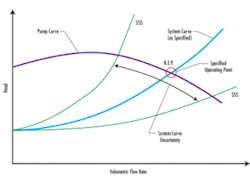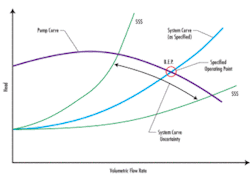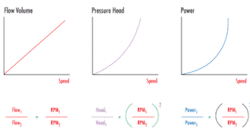Life Cycle Cost Savings in Water Treatment Pumping Systems
By Robert Lax, Karen Sanchez and Vestal Tutterow
Pumping systems account for nearly 25% of all industrial electricity consumption and more than 50% of the electricity used by pumping-intensive fields such as the municipal water and wastewater industries.
Based on a US Department of Energy study, the optimization of pumping systems can reduce a typical facility’s pumping system energy costs by 20% or more. In addition, pumping system optimization projects can typically provide corollary benefits such as life cycle cost savings obtained through reduced maintenance costs, improved system reliability, enhanced process control and extended product quality.
Understanding the components that make up the total cost of a pumping system provides an opportunity to significantly reduce energy, operational, and maintenance costs. Life cycle cost (LCC) analyses measure the costs to purchase, install, operate (including energy costs), maintain, and dispose of all system components. Used as a comparison tool between possible design and overhaul alternatives, LCC analyses offer ways to predict the most cost-effective solutions and make reasonable comparisons using all the available data.
Pumping systems often last 15 to 20 years. Some costs occur at the outset of the system’s installation, while others will be incurred throughout different stages of the life cycle. Therefore, a present or discounted value of the LCC must be calculated to accurately assess the different solutions.
Most water facility pumping systems have life cycle costs dominated by energy and maintenance costs. It is therefore important to accurately determine the current cost of energy, the expected annual energy price escalation of its estimated life, and the anticipated maintenance labor and material costs. Other elements, such as downtime, decommissioning, and environmental protection, can often be estimated based on historical data for the facility.
A well-designed distribution system can affect pumping requirements, potentially allowing for the selection of a smaller pump and motor, thereby reducing both initial purchase and life cycle costs. Once in operation the system should be operated as close to its “Best Efficiency Point” (B.E.P.) as possible. Maximizing efficiency also maximizes system reliability.
As pump operation moves away from the Best Efficiency Point, the energy and maintenance costs will increase and the expected life of the pump will be reduced. A simple calculation can be made to determine Brake Horsepower (BHP):
From this equation it can be seen that pump efficiency differences measuring just a few percentage points (e.g. 74% versus 80%) can have a significant impact on pumping power requirements and energy use. It is critical then to not only install the most efficient pump, but also to match the pump performance accurately to the pump system curve.
Upgrade Opportunities
The opportunities for upgrading existing water treatment pumping system equipment and processes are significant. The first step entails examining current pump efficiencies according to system head curves. As noted previously, the main pumps that bring raw water into the plant and provide overall distribution flow are typically larger horsepower turbine pumps. These pumps are critical to overall performance levels since they consume the largest percentage of energy for the entire facility.
Another opportunity for energy savings that has become increasingly more affordable is the use of Variable Frequency Drives (VFD) or Variable Speed Drives (VSD) for the pump system. A variable speed drive can automatically adjust the speed of the pump motor according to performance conditions. The VFD, the most common type of variable speed drive, uses electronics to vary the frequency and voltage to the motor according to the system requirements, through a pump controller or via a SCADA system. Some of the benefits of using a VFD include:
- Increased operating control and flexibility
- Reduced energy consumption at non-peak times
- Complete motor protection and diagnostics
- User interface and system integration
- Soft starting and stopping
- Reduced equipment wear
For centrifugal pumps (e.g. vertical turbine, end suction) the performance of the system can be predicted by using the “Affinity Laws”. These laws allow the theoretical load requirements and potential energy savings to be quantified. Referring to Figure 2, the first curve shows that rate of flow varies linearly with speed. When one decreases pump speed to 50%, the flow decreases to 50%.
The second curve shows that head varies as the square of speed. At 50% speed, rate of flow will be 50%, but the head is only 25% based on this relationship.
The third curve shows the power required for a particular flow requirement, where energy varies as the cube of speed. If speed is set to 50% of full speed, the rate of flow will be 50%, head will be reduced to 25%, and we consume only 12.5% of the full speed power.
Therefore, the potential for energy savings as the flow requirement changes is tremendous. During non-peak loads in a plant, the drive reduces the speed of the pump motor to meet the lower demand, thus reducing the horsepower and overall electricity usage. When demand increases, the VFD adjusts the speed of the motor to accommodate the larger load. This operation has even greater impact during peak load time because with constant speed operation, it is quite costly to start a 100 hp motor due to peak demand penalties that arise from high in-rush amperage, which can be over 600% of rated full load amps. A VFD is a soft starting device and will not allow the motor to exceed its full load amp rating. Thus the utility company will charge less for starting the larger horsepower turbine pumps with VFDs installed.
Consideration of component upgrades such as VFDs and higher efficiency pumps and motors is just one aspect of a systems approach to pumping system optimization. A systems approach analyzes both the supply and demand sides of a pumping system, while examining how pump performance characteristics and the overall system interact. This approach also shifts the focus from individual components to total system performances to develop system-wide optimization methods that offer far greater savings that could be produced through component upgrades alone.
Conclusion
The overall energy consumption of a water treatment plant is a significant portion of an operating authorities’ budget. For water systems owned and operated by the local municipalities, taxpayers bear the burden of unnecessary operating expenses. To focus on real energy savings within the plant, it is vital to understand the pumping system network. This includes knowing true system requirements at peak and non-peak loads, as well as increasing the efficiency of pump systems and their components. WW
About the Authors:
Robert Lax is Product Manager for ITT Goulds Residential & Commercial Group. Karen Sanchez is Marketing Manager for ITT Goulds Residential & Commercial Group. Vestal Tutterow is Senior Program Manager for the Alliance to Save Energy.
Pump Systems Matter
Developed by the Hydraulic Institute (HI), Pump Systems Matter (PSM) is an educational initiative created to assist North American pump users gain a more competitive business advantage through strategic, broad-based energy management and pump system performance optimization. PSM’s mission is to provide the marketplace with tools and collaborative opportunities to integrate pump system performance optimization and efficient energy management practices into normal business operations.
Pump Systems Matter will be hosting a course in conjunction with the Water Quality Association (WQA) Aquatech USA 2009 conference to be held March 17 – 21, 2009, in Chicago, Illinois. The course, entitled “Pumping System Optimization: Opportunities to Improve Life Cycle Performance,” will be held on March 19 from 8:30 am – 4:00 pm. For more information on the WQA conference and PSM’s course, please visit www.PumpSystemsMatter.org or www.wqa.org.



